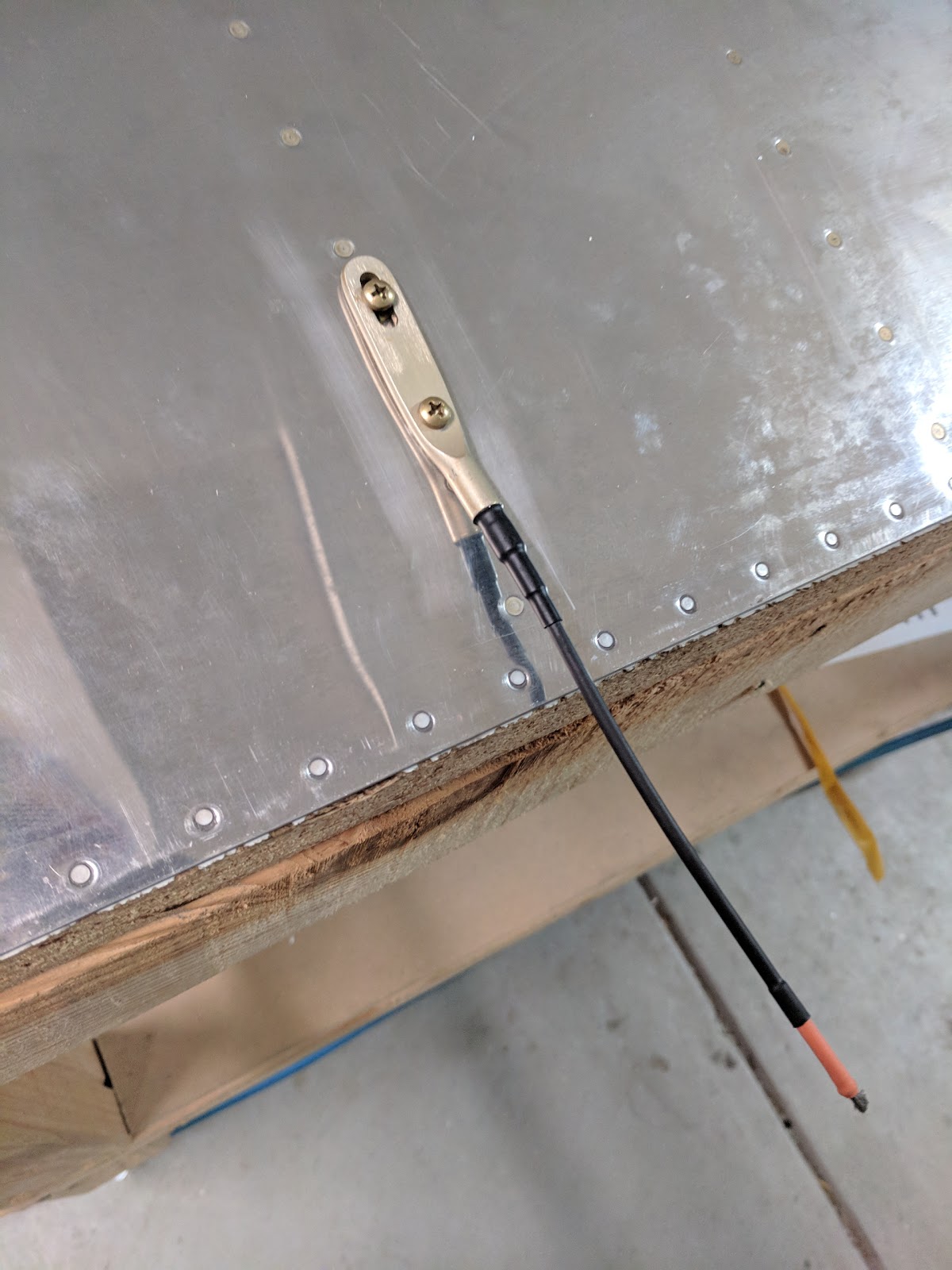Static Wick Aircraft - This image of what looks like "nozzles" is now being shared on social media as proof that the secret spraying program uses commercial jets (ie the "chemtrail" theory).
However, these are just static reduction wicks, short sections of wire bolted to the wings that reduce any build-up of static electricity. Without these wicks, static electricity can build up on the wings and uncontrolled sparks can interfere with communication and navigation equipment.
Static Wick Aircraft

The image that is being passed around has a very forced perspective. It looks like wicks along the entire length of the wing, but it's actually only a few meters towards the tip of the wing. The walls are barely visible in most pictures of the 747-8F because the plane is so big and the walls are so small.
File:static Discharger With Plastic Guards.jpg
Below is a patent for static discharge Wick. It's basically a piece of multi-strand steel cable, covered in plastic, less than half an inch thick.
There is actually a "nozzle" in the picture, a fuel drain valve. From a power point of view, it looks like it's in the middle of the wing, but it's actually near the end (with the wicks)
Here is the vent in action. Jets sometimes have to dump fuel when returning after takeoff (or landing halfway to their destination) due to emergency situations.
And here's a picture of the fuel dump with the static wick visible, giving it a nice scale. This is on a 777.
Mystery Of The Spikes On Plane Wings Solved: Static Wick Explanation
I found this small tube like object discussed in the forum in 2009, this picture is what was discussed.
Prodiax: These static wicks also created controversy. A man has spied a plane undergoing maintenance and claimed that the system was actually used to release products. External source content I looked up static wicks and headed down the path of the Boeing PDF file to find the supplier of the item in question, HR Smith (Technical Development) Ltd., and a link to the product page.
Thanks to @Fin for the original question. I'll hijack the OP for a more detailed and useful explanation/debunking
From the Airbus manual. This shows where they are and how many are missing or served. Airbus calls them "Static Dischargers".
Cessna 414 Dayton Granger Static Wick
Gridlock said: Not many things on the plane are allowed to lose 1/5 of .... interesting, thanks. Click to expand...
Depends on the plane. My place has a chart of what the A-10 is designed to fly without. That's... Enlightening.
The aircraft was designed to fly with one engine, one tail, one elevator and half a wing missing.[51] Content from external sources https://en.m.wikipedia.org/wiki/Fairchild_Republic_A-10_Thunderbolt_II
Mick West said: And here is a picture of a fuel dump with static wicks visible, giving a good sense of scale. This is on a 777. Click to expand... I found a close up of this in my iPhoto library. Retrieved December 6, 2011 from United Airlines flight 935: Maintenance scheduled to affect the Stack Overflow & Stack Exchange Network site and chat is scheduled for Thursday January 19th from 9:00 PM to Friday, January 20th at 12:00 PM EST (Friday) January 20th 02:00 - 05 :00 UTC). The sites will be in WRITING ONLY mode during this period.
Safeway Aviation Static Wick Protector Pn 7101 5
Stack Exchange is a question and answer site for aircraft pilots, mechanics and enthusiasts. It only takes a minute to register.
I recently personally saw an SU-27 belonging to the Ukrainian Air Force. I noticed some elements protruding from the tail and I wonder what they are called and what they do?
I believe these are static discharge wicks. You can see a similar size / shape of wicks in the 1/32 scale model of the SU-27 discussed here but, more importantly, you can find them marked with the number 53 in the cutaway image below. The label is written as Разрядники статического злектричества, which according to Google Translate is "ESD arrestor" (or static discharge wick).

This is different from the shape of the wicks found in most US GA aircraft (just a straight wire, potentially with some insulation around the bottom), but, as discussed on Aerospaceweb, the Wick design (mainly the inverted cone shape shown). Here) helps to increase the gradient in the electric field from the edge to the bottom of the wall. This encourages accumulated charge to migrate back into the atmosphere from the controlled point and reduces interference with on-board electronics and radio systems.
Static Wing Marker
By clicking "Accept all cookies", you agree that Stack Exchange may store cookies on your device and disclose information in accordance with our cookie policy. This article requires additional references for verification. Please help improve this article by adding citations to reliable sources. Non-source material may be challenged and removed. Find source: "Static discharger" – news · newspaper · book · scholar · JSTOR (December 2009 ) (Learn more about how and what to delete this template message)
Static dischargers, also called static wicks or static discharge wicks, are devices used to remove static electricity from aircraft in flight. It is shaped like a small stick that points back from the wing and is installed on almost all civilian aircraft.
Static precipitation is an electrical charge on an aircraft caused by flying through rain, snow, ice or dust particles. Charge is also accumulated through friction between the airframe and the air. If the plane's load is large, it is discharged into the surrounding air. Without static dischargers, the charge is discharged in large batches through pointed plane extremities, such as antennas, wingtips, vertical and horizontal stabilizers, and other projections. The release creates broadband radio frequency noise from DC to 1000 MHz, which can affect aircraft communications.
To control this discharge, to allow continuous operation of navigation and radio communication systems, static dischargers are installed on the trailing edges of the aircraft. This includes (electrically grounded) ailerons, elevators, rudder, wings, horizontal and vertical stabilizer tips. A static discharger is a high electrical resistance device (6-200 megohms) with a lower corona voltage and a sharper point than the surrounding aircraft structure.
Static Wick Damaged By Lightning Strike.
Static dischargers are not lightning arresters and do not affect the likelihood of an aircraft being struck by lightning. It will not work if they are not properly attached to the plane. There must be a conductive path from all parts of the aircraft to the exhaust or they are useless. Access panels, doors, hoods, navigation lights, antenna mounting brackets, control surfaces, etc. can create static noise if they cannot be discharged through the static wick.
Part of the static discharger in the aircraft. Note two sharp metal micropoints and protective yellow plastic.
The static dischargers were first developed by a joint Army-Navy team led by Dr. Ross Gunn of the Naval Research Laboratory and was attached to military aircraft during World War II. They proved to be effective in extreme weather conditions in 1946 by the United States Air Force team led by Captain Ernest Lynn Cleveland.
Static display aircraft, wick aircraft, aircraft static discharge wicks, static model aircraft, aircraft pitot static system, aircraft static discharge, aircraft propeller static balancing, static vent aircraft, static display aircraft for sale, aircraft static, static wick, static wick covers


